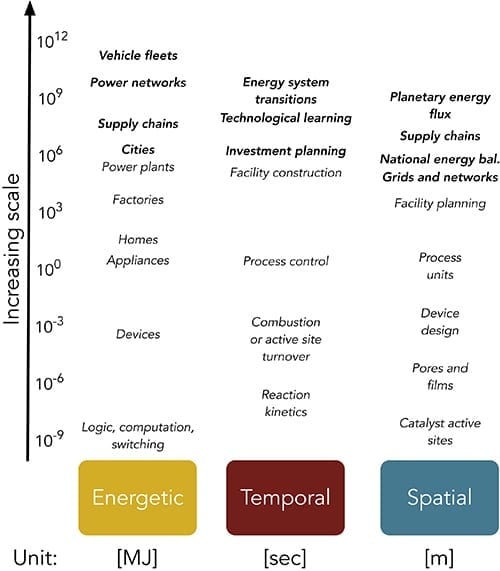
What types of electricity storage could have the biggest impact globally for a low-carbon energy future? Can humanity simultaneously de-carbonize energy and extend heat, lighting and transportation to more than a billion people now living with without modern energy services?
These are the types of big-picture questions that are being answered by the research that fits into a new academic discipline—“macro-energy systems”—proposed by a group of researchers led by Stanford University.
“Macro-energy systems as a discipline illuminates the dynamics, benefits, costs and impacts of large-scale energy system transitions,” says Sally M. Benson, co-director of Stanford’s Precourt Institute for Energy and senior author of the perspective published Wednesday in the academic journal Joule. Benson is a professor in Energy Resources Engineering.
The new discipline would addresses topics that account for a large portion of energy use, like the global car fleet, or cover vast geographical regions, like supply chains, or that cover decades, like energy investments. The large spatial, temporal, or energy scale of these issues requires researchers, no matter what department or discipline they come from, to use similar techniques like modeling and abstraction.
“Macro-energy systems research and education is happening already, but it’s being done in different departments and published under disparate academic journals,” says lead author Patricia Levi, a PhD candidate in Stanford’s Management Science & Engineering Department.
Formalizing this research and education as a discipline would have many benefits, Levi says. Discipline-specific journals, conferences and funding bodies would improve research by establishing core methods and terminology, making peer review more credible, fostering collaboration, and avoiding redundant work.
“An example of the pitfalls of not doing this is the sphere of ‘energy analysis,’ which is also called ‘net energy analysis,’ and ‘energy return on investment’ analysis. This concept has been re-invented numerous times over decades from multiple directions by multiple actors, but still lacks a consistent methodology,” says co-author Michael Carbajales-Dale, who heads the Energy-Economy-Environment Systems Analysis group at Clemson University, where he is an assistant professor in the Environmental Engineering & Earth Sciences Department.
The creation of macro-energy systems will also help its practitioners convince other researchers, policymakers, companies and funders of the value of their research, the authors write.
“Unification of different areas under the umbrella of macro-energy systems will also make it more identifiable for new students, and in turn help them find jobs after they complete their education because relevant hiring managers will understand what they studied,” says co-author Simon Davidsson Kurland, a postdoctoral researcher at Chalmers University of Technology in Sweden.
As first steps, the authors ask that academics who think that their work is described by the paper begin to identify their discipline as macro-energy systems and champion that term with their peers. Second, they envision a meeting to chart the scope and direction of research and education in the discipline.
Learn more: New discipline proposed: Macro-energy systems—the science of the energy transition
The Latest on: Macro-energy systems
[google_news title=”” keyword=”Macro-energy systems” num_posts=”10″ blurb_length=”0″ show_thumb=”left”]
via Google News
The Latest on: Macro-energy systems
- Northern Graphite Provides Development Update on Its Patented Porocarb(R) Product for All-Solid-State-Battery Technologieson May 2, 2024 at 1:30 am
A number of global automakers are working to commercialize ASSB chemistries that will enable longer driving distances, faster charging and an overall safer energy storage system. Based on information ...
- Berkshire Hathaway Class B stock closes in green and emerges from a six-day red spellon May 1, 2024 at 1:04 pm
Class B shares of Berkshire Hathaway (MRNA) closed in green and snapped a six-day losing streak after having lost 2.9% over the last six trading sessions. Shares of the company closed +1.8% at $398.57 ...
- China May Be Preparing to Deploy Economic 'Nuclear Option'on April 30, 2024 at 10:52 am
China claims democratic Taiwan as its territory, though Beijing's ruling Chinese Communist Party has never governed there. U.S. officials believe Xi has instructed Chinese forces to be prepared to ...
- AMERICAS Yen slips anew with Amazon due, Treasury plans irkon April 30, 2024 at 2:02 am
Apple (AAPL.O), which reports earnings on Thursday, gained 2.5% following a report the iPhone maker had renewed discussions with OpenAI about using the startup's generative artificial intelligence ...
- Best Macro Tracking Apps: MyFitnessPal Reviewon April 26, 2024 at 6:59 am
There are many macro-tracking apps out there, but for the complete health picture, MyFitnessPal is one of the best.
- Best Macro Tracking Apps: MyFitnessPal Reviewon April 25, 2024 at 5:00 pm
(Ad) There are many macro-tracking apps out there ... you get access to a complete and accurate system for tracking your eating, exercise, and overall wellness—access that’s yours 24/7 ...
- The Macro-Impact of the Microgridon April 24, 2024 at 4:44 am
Approximately 80 million kilometers of the world’s power grids – which have served as the delivery method of electricity for more than a century – need to be replaced before ...
- Distributed Energy Resource Management System Market Size to Surpass USD 1.97 Billion by 2031 with a CAGR of 19.4% from 2024 to 2031on April 22, 2024 at 9:38 am
Distributed Energy Resource Management System Market Size to Surpass USD 197 Billion by 2031 with a CAGR of 194 from 2024 to 2031 ...
- Energy market in state of stark divide amid turbulent geopolitics and instability – WTWon April 17, 2024 at 6:40 am
Despite these market dynamics, WTW finds that the energy sector remains robust, with no indications of insurers planning to exit. The availability of risk and performance data has also sharpened ...
- The Macro Telleron April 5, 2024 at 11:39 pm
The Macro Teller has over 30 years of investing experience, including 25 as an investment manager. He holds a BA in Accounting and Economics, as well as an MBAin Finance. He is a licensed CPA and ...
via Bing News









